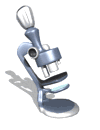
THE CELL THEORY
In most cases, individual cells are so small that they cannot be seen without the use of a
microscope. Although the first microscopes to be developed were very crude by today's standards,
they allowed people to make some
amazing new discoveries. For example, Galileo saw details of
insect eyes with two crude lenses in a tube. Robert Hooke used
simple lenses to observe cork in which he saw tiny
compartments he called cellulae. van Leeuwenhoek was able to
see protistans, sperm, even bacteria.
The observations of the early microscopists led to the formulation of the Cell Theory. Schleiden and Schwann believed that animals as well as plants consisted of cells. Virchow said that all cells come from preexisting cells.
The cell theory has three generalizations:
When I was a student, I spent hundreds of hours in laboratory classes. Each biology course had at least one 3 hour lab a week, and most had 2 labs per week. Much of this time was spent looking at things through microscopes. It seems that today, students often feel they "have" to take a lab rather than they "get" to take a lab. Thanks to the Virtual Microscope web site, you can actually get a feel for what it is like to look through a microscope without ever having to go to a biology lab.
You are welcome to look at any specimens you want, but since this is a biology course, please use the drop down menu where it says "Choose a Sample:" and look at the onion root mitosis example at each of the 6 magnifications 25X to 1000X. The small purple boxes are individual cells in the root of an onion. The black area within each box is the nucleus of the cell. At the highest magnification, you are looking at chromosomes which are composed of chains of DNA (deoxyribonucleic acid).
This animation (Audio - Important) describes how a microscope works.
The development of first the electron microscope, and later the scanning electron microscope (SEM) allowed scientists to see specimens in incredible detail. There are some really cool images here. Look at several that interest you. Be sure to use the magnification slider. Be patient as the samples load. Think about how many hours you are saving by not having to take a lab.
REVIEW: �One portion of the cell theory states that
REVIEW: Four of the five answers listed below are portions of a well-known theory. Select the exception.
a. Cells are the structural and functional components of living things.
b. Cells arise from preexisting cells.
c. All organisms are composed of cells.
d. Cells are the basic living unit or organization of living things.
e. All cells have a nucleus.��
PREVIOUS
NEXT
LECTURE 4 INDEX
MAIN INDEX